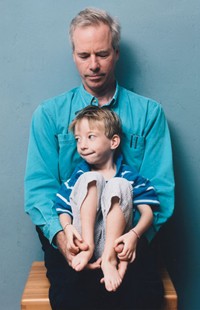 It’s been ages since I last checked in with Hugh Rienhoff, the Bay Area biotech entrepreneur who I profiled in the February 2009 issue of Wired. For those unfortunates among you who haven’t read the piece, Rienhoff has spent much of the past six years analyzing his young daughter’s DNA, in the hopes of discovering the reason she appears to be afflicted with a genetic disorder that bears some resemblance to Marfan syndrome. He does the bulk of this work in the attic of his home, where he spends countless late-night hours scanning reams of sequencing data.
It’s been ages since I last checked in with Hugh Rienhoff, the Bay Area biotech entrepreneur who I profiled in the February 2009 issue of Wired. For those unfortunates among you who haven’t read the piece, Rienhoff has spent much of the past six years analyzing his young daughter’s DNA, in the hopes of discovering the reason she appears to be afflicted with a genetic disorder that bears some resemblance to Marfan syndrome. He does the bulk of this work in the attic of his home, where he spends countless late-night hours scanning reams of sequencing data.
My story ends with Rienhoff vowing to soldier on after encountering a number of dead ends, and admitting that the work itself has taken on a quasi-spiritual aspect. (He compared his quest to that Peter Matthiessen undertakes in The Snow Leopard, which resulted in zero leopard sightings, but some measure of inner peace.) But according to this recent update, Rienhoff may finally be making some important headway:
There are hundreds of genes that encode proteins involved in TGF-beta signal transduction or regulation, including, says Rienhoff, 32 other members of the TGF-beta ligand family and five known receptors. Moreover, Rienhoff found his daughter had 932 instances of homozygosity. Which one, if any, could account for Beatrice’s disorder?
In late 2009, as Rienhoff trawled through Beatrice’s transcriptome data, one of those homozygous gene variants stood out. “It took God-damn forever to find it. I had to sift through everything by hand,” says Rienhoff. “It was basically just brute force, hand-to-hand combat with this data.”
The allele in question is the insertion of a single T nucleotide in the gene for copine-1 on chromosome 20. Copine-1 is a protein involved in one arm of the TGF-beta signaling cascade. The insertion disrupts the gene’s reading frame and results in premature termination. “So that was cool,” says Rienhoff. “It was the only candidate with an insertion allele causing frameshift and nonsense-mediated decay signals…”
Rienhoff says copine-1 has not been well studied in humans or any other organism for that matter. It is highly conserved, however, indicative of some functional importance. One of Rienhoff’s collaborators is Alan Beggs, a geneticist at Boston’s Children’s Hospital (Harvard Medical School). “He’s been my deep throat in muscle biology,” says Rienhoff.
“By studying the rare, and possibly unique condition in his own daughter, Hugh may have discovered something of basic importance that may also have implications for a much broader group of patients,” Beggs says. “Of course, the ability for a single individual to direct this kind of research into their own genetics is truly transformative for how we view genetic studies.”
I bolded the last point because it really gets at the heart of why this is an important story. Granted, the number of people on Earth with Rienhoff’s brains and expertise is vanishingly small, so it’s not like every parent of an undiagnosed child will be able to run out, buy an off-the-shelf sequencer, and figure out what ails their offspring. But there is the potential for collaborative work, using a network of volunteers and quasi-professionals who each provide a small piece of the diagnostic puzzle. And that network can exist outside the realm of the mainstream health-care system, thanks to the democratization of genetic information.
To put it another way, the Wikipedia approach is coming to ever-more sophisticated corners of health care. And not a moment too soon, given how often people lack access to face-to-face genetic expertise. I, for one, don’t even want to ponder the contortions I’d have to go through to get a referral to a geneticist via my HMO.


Like gas stations in rural Texas after 10 pm, comments are closed.